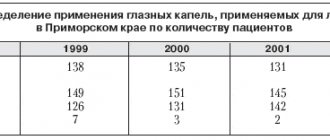Pharmacodynamics and pharmacokinetics
Pharmacodynamics
Antiglaucoma drug, synthetic analogue of prostaglandin F2α . On the one hand, it dilates the blood vessels of the eye, activates the outflow of aqueous humor and improves microcirculation, which normalizes intraocular pressure . On the other hand, it regulates cellular metabolism, improves tissue trophism, increasing the content of cAMP . This allows it to be used in open-angle glaucoma as a monotherapy drug.
A decrease in intraocular pressure is observed after 3-4 hours, and the overall effect lasts 24 hours.
Pharmacokinetics
Penetrates through the cornea and is hydrolyzed to its active form. Cmax in aqueous humor is achieved 2 hours after instillation. Metabolism occurs in the liver; it is almost not metabolized in the tissues of the eye. Metabolites have weak activity. Excreted by the kidneys. The half-life is 17 minutes.
Contraindications
Glauprost should not be prescribed to patients under 18 years of age, or if there is hypersensitivity to the components of the drug.
Caution is required in the treatment of people with aphakia, a high risk of developing macular edema, pseudophakia (with rupture of the posterior lens capsule), and other types of glaucoma (neovascular, congenital, inflammatory).
Treatment of pregnant women is carried out only under the strict supervision of a doctor, subject to high expected benefit. Since the drug and its metabolites can pass into breast milk, it is better to avoid breastfeeding during the treatment period.
Side effects
- Pain in the eyes;
- burning sensation in the eyes;
- blurred vision;
- feeling of sand in the eyes;
- itching;
- swelling of the eyelids;
- blepharitis;
- lengthening eyelashes and enhancing their pigmentation;
- conjunctival hyperemia
- change in iris pigmentation;
- darkening of the skin of the eyelids;
- dyspnea;
- dizziness;
- attacks of bronchial asthma ;
- pain in muscles and joints.
Glauprost, instructions for use (Method and dosage)
Place 1 drop in the eyes 1 time in the evening. If the procedure is missed, then the next dose is administered at the prescribed time the next day, without doubling it.
The use of the drug causes a change in eye color due to an increase in brown pigment. It is usually observed in individuals with mixed iris color. If there is an intense change in pigmentation, treatment is stopped. Patients who use drops in one eye may experience heterochromia . The doctor informs the patient about the likelihood of eye color changes. Changes in eyelashes in the form of lengthening and thickening disappear after treatment.
If other eye drops are prescribed, they should be administered at intervals of 5 minutes. Before the procedure, contact lenses are removed and reinserted after 15 minutes.
Glauprost eye drops 0.005% 2.5 ml dropper bottle 3 pcs. in Moscow
Latin name
GLAUPROST
International nonproprietary name
latanoprost
Release form
eye drops 0.005%
Package
2.5 ml - polymer dropper bottles (3) - cardboard packs.
Description
Eye drops are transparent, colorless.
pharmachologic effect
Antiglaucoma drug. It is an analogue of prostaglandin F2α and a selective agonist of FP receptors (prostaglandin F). Reduces intraocular pressure by increasing the outflow of aqueous humor. The decrease in intraocular pressure begins 3-4 hours after administration of the drug, the maximum effect is observed after 8-12 hours, the effect lasts for at least 24 hours. Studies in animals and humans have shown that the main mechanism of action is an increase in uveoscleral outflow, in addition , improved outflow (reduced outflow resistance) has also been described in humans. It has been established that latanoprost does not have a significant effect on the production of aqueous humor and the blood-ophthalmic barrier. Animal studies have shown that in therapeutic doses, latanoprost does not affect (or only slightly) the intraocular circulation. When applied topically, mild to moderate conjunctival or episcleral injection is possible. According to fluorescein angiography, long-term treatment with latanoprost after extracapsular cataract extraction in monkeys had no effect on retinal blood circulation. When used short-term, latanoprost did not promote fluorescein leakage in the posterior segment of the eye of patients with artificial lenses. When used in therapeutic doses, latanoprost does not have a significant pharmacological effect on the cardiovascular and respiratory systems.
Indications
reduction of elevated intraocular pressure (IOP) in adults and children (over 1 year of age) with open-angle glaucoma or ocular hypertension.
Directions for use and doses
Adults (including elderly patients) 1 drop into the affected eye(s) 1 time/day. The optimal effect is achieved when using the drug in the evening. The drug should not be instilled more often than once a day, since more frequent administration has been shown to reduce the hypotensive effect. If one dose is missed, treatment is continued as usual. As when using any eye drops, in order to reduce the possible systemic effect of the drug, immediately after instillation of each drop, it is recommended to press for 1 minute on the lower lacrimal opening, located at the inner corner of the eye on the lower eyelid. This procedure must be performed immediately after instillation. Before instillation, it is necessary to remove contact lenses and install them no earlier than 15 minutes after insertion. If several ophthalmic dosage forms are used simultaneously, their use should be separated by a 5-minute interval. Children Latanoprost is used in children in the same dose as in adults. There are no data on the use of the drug in premature infants (gestational age <36 weeks). Data in children under 1 year of age are very limited.
Compound
1 ml latanoprost 50 mcg Excipients: disodium hydrogen phosphate dodecahydrate - 17 mg, sodium dihydrogen phosphate dihydrate - 7 mg, sodium chloride - 3 mg, benzalkonium chloride - 0.2 mg, purified water - up to 1 ml.
Contraindications
hypersensitivity to the components of the drug; age up to 1 year (efficacy and safety have not been established); pregnancy; lactation period. The drug should be used with caution in patients with aphakia, pseudophakia with rupture of the posterior capsule of the lens, in patients with known risk factors for macular edema (cases of development of macular edema, including cystoid, have been described during treatment with latanoprost), in patients with inflammatory, neovascular or congenital glaucoma (due to lack of sufficient experience in using the drug).
Use during pregnancy and breastfeeding
The safety of latanoprost in pregnant women has not been established. Latanoprost may have toxic effects on pregnancy, the fetus and the newborn. Use during pregnancy is contraindicated. Latanoprost and its metabolites may be excreted in breast milk. Use during breastfeeding is contraindicated. If it is necessary to use the drug during lactation, breastfeeding should be stopped. The effect of latanoprost on male and female fertility was not found in experimental studies on animals.
special instructions
The use of latanoprost can gradually change eye color by increasing the amount of brown pigment in the iris. Before starting treatment, patients should be informed about the possible permanent change in eye color. Using the drug in one eye may cause irreversible heterochromia. This effect occurs predominantly in patients with mixed iris colors, such as blue-brown, gray-brown, green-brown, or yellow-brown. In studies of latanoprost, darkening usually began within the first 8 months of treatment, rarely during the second or third year, and was not observed after 4 years of treatment. The progression of iris pigmentation decreased over time and stabilized after 5 years. There is no data on increased pigmentation over 5 years. In a 5-year open-label safety study of latanoprost, 33% of patients developed iris pigmentation. In most cases, the change in iris color was minor and often not clinically detected. The incidence ranges from 7% to 85% in patients with mixed iris color, predominant in patients with yellow-brown iris. No changes were observed in patients with a uniformly colored blue iris; in rare cases, changes were observed in uniformly colored gray, green and brown irises. The change in eye color is caused by an increase in the melanin content in the stromal melanocytes of the iris, and not by an increase in the number of melanocytes themselves. In typical cases, brown pigmentation appears around the pupil and extends concentrically to the periphery of the iris. In this case, the entire iris or parts of it become brown. After discontinuation of therapy, no further pigmentation was noted. According to available clinical data, the color change was not associated with any symptoms or pathological disorders. The drug has no effect on nevi and lentigines of the iris. According to the results of 5-year clinical studies, pigment accumulation in the sclero-corneal trabecular meshwork or other parts of the anterior chamber of the eye was not noted. It has been shown that darkening of the iris does not lead to undesirable clinical consequences, so the use of latanoprost when such darkening occurs can be continued. However, such patients should be monitored regularly and, depending on the clinical situation, treatment may be discontinued. Experience with the use of latanoprost in the treatment of angle-closure and congenital glaucoma, pigmentary glaucoma, and open-angle glaucoma in patients with pseudophakia is limited. There is no information on the use of latanoprost in the treatment of secondary glaucoma due to inflammatory eye diseases and neovascular glaucoma. Latanoprost has no effect on pupil size. Due to the lack of experience with the use of latanoprost in the treatment of acute attacks of angle-closure glaucoma, the drug should be used with caution in such patients. Due to the fact that information on the use of latanoprost in the postoperative period of cataract extraction is limited, caution should be exercised when using the drug in this category of patients. Caution should be exercised when using latanoprost in patients with a history of herpetic keratitis. In case of acute herpetic keratitis, as well as in the case of anamnestic information about chronic recurrent herpetic keratitis, it is necessary to avoid prescribing latanoprost. Macular edema, incl. cystic, was observed during latanoprost therapy mainly in patients with aphakia, pseudophakia, rupture of the posterior capsule of the lens, or in patients with risk factors for the development of cystoid macular edema (in particular, with diabetic retinopathy and retinal vein occlusion). Caution should be exercised when using latanoprost in patients with aphakia, pseudophakia with posterior capsular rupture or anterior chamber intraocular lenses, or in patients with known risk factors for cystoid macular edema. Caution should be exercised when using latanoprost in patients with risk factors for developing iritis/uveitis. Experience with the use of latanoprost in patients with bronchial asthma is limited, but in some cases, exacerbation of asthma and/or the appearance of shortness of breath were observed in the post-registration period. Caution should be exercised when using latanoprost in this category of patients. There have been cases of darkening of the skin of the periorbital area, which in a number of patients was reversible with continued therapy with latanoprost. Latanoprost can cause gradual changes in eyelashes and vellus hair, such as lengthening, thickening, increased pigmentation, increased thickness, and a change in the direction of eyelash growth. Changes in eyelashes were reversible and disappeared after cessation of therapy. Glauprost contains benzalkonium chloride, often used as a preservative in ophthalmic medications. Benzalkonium chloride may cause eye irritation, punctate keratopathy and/or toxic ulcerative keratopathy, and may be absorbed and discolored by soft contact lenses. Careful monitoring of the condition of patients with dry eye syndrome or other corneal diseases is required during long-term use of latanoprost. Before using the drug, you must remove contact lenses and reinsert them no earlier than 15 minutes after instillation. Use in pediatrics Information on the effectiveness and safety of latanoprost in children under 1 year of age is limited. There is no experience with the use of the drug in premature infants (gestational age less than 36 weeks). There is no information on the safety of long-term use of latanoprost in children. For primary congenital glaucoma in children aged 0 to 3 years, surgery (goniotomy/trabeculotomy) remains the standard treatment. Effect on the ability to drive vehicles and operate machinery As with the use of other ophthalmic drugs, temporary visual impairment is possible; It is not recommended to drive vehicles or operate machinery until it is restored.
Side effects
Most of the adverse reactions were observed in the organ of vision. In an open-label 5-year safety study, 33% of patients developed iris pigmentation. Other undesirable reactions from the organ of vision are usually transient and are noted immediately after instillation. The gradation of adverse reactions according to frequency of occurrence was carried out as follows: very often (>1/10); often (≥1/100, <1/10), infrequently (≥1/1000, <1/100), rarely (≥1/10,000, <1/1000), very rarely (<1/10,000), frequency unknown (frequency cannot be estimated based on available data). Infections and infestations: frequency unknown - herpetic keratitis. On the part of the organ of vision: very often - hyperpigmentation of the iris, hyperemia of the conjunctiva, mild to moderate eye irritation (burning sensation, feeling of sand in the eyes, itching, tingling and foreign body sensation), changes in eyelashes (increase in length, thickness, number and pigmentation); often - transient point erosions of the epithelium (mostly asymptomatic), blepharitis, pain in the eye; uncommon - swelling of the eyelids, dry mucous membrane of the eye, keratitis, blurred vision, conjunctivitis; rarely - iritis/uveitis (mainly in predisposed patients), macular edema, eyelid edema, corneal edema, corneal erosion, periorbital edema, darkening of the eyelid skin, eyelid skin reactions, change in the direction of eyelash growth, thickening, darkening and lengthening of eyelashes, distichiasis , photophobia; very rarely - changes in the periorbital area and in the eyelash area, leading to a deepening of the furrow of the upper eyelid; frequency unknown - iris cyst. From the nervous system: frequency unknown - dizziness, headache. From the cardiovascular system: very rarely - aggravation of angina in patients with concomitant angina; frequency unknown - feeling of heartbeat. From the respiratory system: rarely - bronchospasm (including exacerbation of the disease in patients with a history of bronchial asthma), shortness of breath. From the skin and subcutaneous tissues: infrequently - rash; rarely - darkening of the skin of the eyelids and local skin reactions on the eyelids. From the musculoskeletal system: frequency unknown - myalgia, arthralgia. Other: very rarely - chest pain. Children Based on the results of two short-term (≤12 weeks) clinical studies in 93 children, the safety profile of latanoprost in children did not differ from the safety profile in adults. The safety profile between different age groups in children is comparable. Compared with the adult population, nasopharyngitis and fever were most frequently reported in children.
Drug interactions
There are no clear data on drug interactions with latanoprost. With the simultaneous instillation of two prostaglandin analogs, a paradoxical increase in IOP has been described, therefore the simultaneous use of two or more prostaglandins, their analogs or derivatives is not recommended. In vitro studies have shown that a precipitate is formed when eye drops containing thiomersal are mixed with eye drops containing latanoprost. If it is necessary to use these drugs simultaneously, a 5-minute interval between their instillation should be observed.
Storage conditions
The drug should be stored out of the reach of children, protected from light at a temperature of 2° to 8°C. After opening the bottle, the drug should be stored at a temperature not exceeding 25°C and used within 42 days.
Reviews of Glauprost
According to research results, Glauprost eye drops in patients with intraocular pressure of 24-25 mm Hg. Art. reduced it by 6-8 mm Hg. Art. If we compare its effectiveness with timolol , then one instillation of Glauprost is equivalent to 2 times a day of timolol. This drug has a longer and more pronounced hypotensive effect, as evidenced by patient reviews.
- “... Glauprost suits the fact that you can drip only once a day. I tolerate the treatment well, there is no eye irritation.”
- “... My husband uses these drops, they help well, but after six months we noticed a change in eye color. The doctor didn’t warn us, so we panicked.”
- “... They help well, but are a little expensive, considering that treatment for glaucoma is lifelong.”
Negative reviews note side effects such as redness and pain in the eyes, unbearable itching and conjunctivitis , due to which the drug was discontinued. Its high cost is also noted.
List of eye drops prescribed for glaucoma
- Azarga
- Azopt
- Alphagan
- Arutimol
- Betoptik
- Ganfort
- Glauprost
- Dorzopt
- Dorzopt plus
- Duoprost
- DuoHerbs
- Combigan
- Kosopt
- Xalatan
- Xalacom
- Xalatamax
- Xonephus
- Okumed
- Oftan timogel
- Pilocarpine
- Pilotimol
- Proxodolol
- Taflotan
- Timolol
- Travatan
- Trusopt
- Fotil
It must be remembered that regarding the use of all the drugs mentioned above, it is imperative to consult a qualified ophthalmologist.
Glauprost price, where to buy
You can buy Glauprost at any pharmacy. The cost of one 2.5 ml dropper bottle is 525-842 rubles.
- Online pharmacies in RussiaRussia
ZdravCity
- Glauprost eye drops 0.005% 2.5 ml 3 pcs. K.O.Rompharm Company S.r.L.
RUB 1,749 order - Glauprost eye drops 0.005% 2.5 mlK.O.Rompharm Company S.r.L.
780 rub. order




